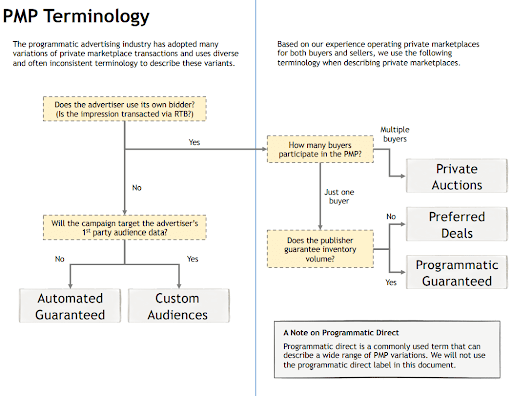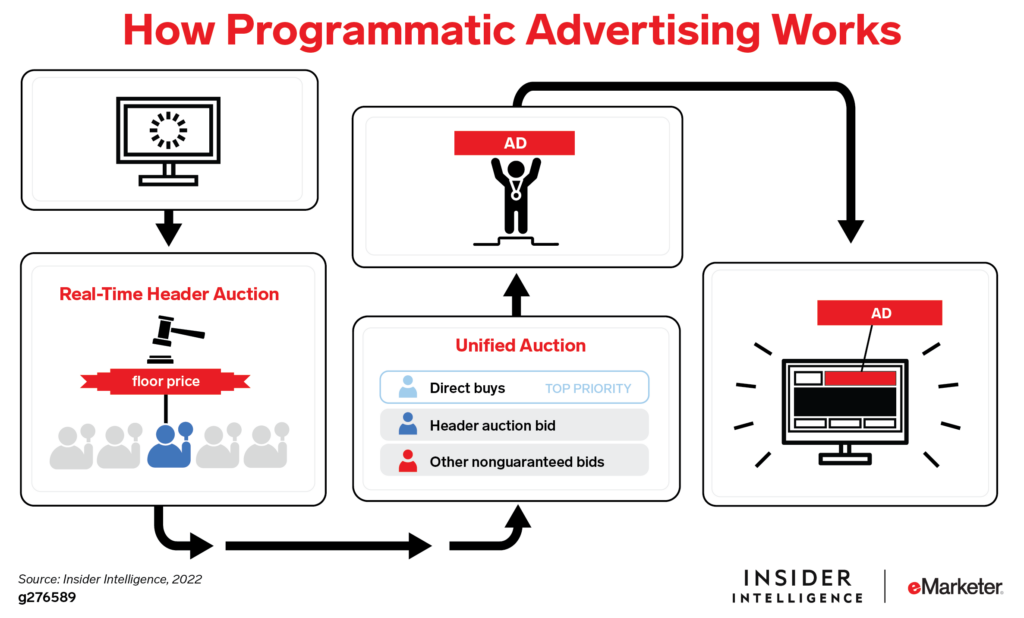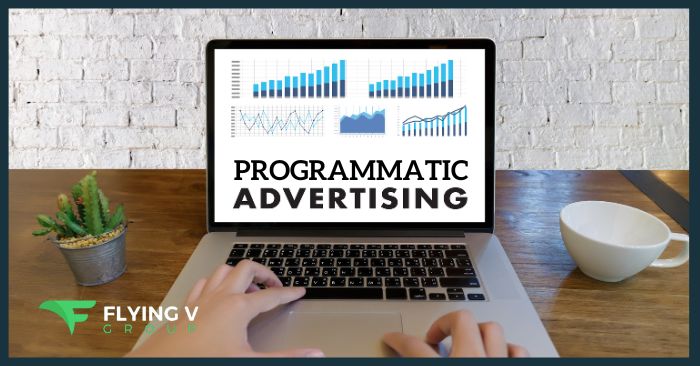Let’s start by understanding what a Programmatic Advertising Glossary is and why it matters in the landscape of digital marketing.
Programmatic advertising glossary serves as a valuable tool for both newcomers and seasoned professionals.
It is a curated collection of definitions and explanations for the multitude of terms, acronyms, and buzzwords that abound in this dynamic industry.
Think of it as your trusty dictionary for the digital advertising realm.
Programmatic advertising itself is a data-driven approach to buying and selling digital ads in real time, using automated processes and algorithms to target specific audiences.
Within this landscape, various terms and concepts can seem like a foreign language, making it challenging to keep up with industry trends and make informed decisions.
Our comprehensive guide aims to bridge that knowledge gap. This resource is actually designed to simplify the learning process.
We’ll break down complex ideas into digestible, easy-to-understand definitions, ensuring that you’re well-equipped to navigate the world of programmatic advertising with confidence.
We will demystify the programmatic advertising glossary, one term at a time.
Let’s begin by exploring the essential terms and concepts that define the programmatic advertising glossary.
- Understanding Programmatic Advertising Glossary
- Key Terms in Programmatic Advertising Glossary
- Understanding Programmatic Advertising Tools
- Importance of Programmatic Advertising Glossary
- FAQs
- 1. What is a Programmatic Advertising Glossary?
- 2. Why is Understanding Programmatic Advertising Glossary Important?
- 3. What Are Some Key Terms in Programmatic Advertising Glossary?
- 4. How Can Programmatic Advertising Tools Improve Campaign Performance?
- 5.Why Should Marketers Stay Informed About Programmatic Advertising Glossary?
Understanding Programmatic Advertising Glossary

Image from The Magazine Manager
In order to fully grasp the programmatic advertising landscape, it’s crucial to have a solid understanding of the key terms and concepts that define the programmatic advertising glossary.
Real-Time Bidding (RTB)
RTB is a process that allows advertisers to bid on ad inventory in real-time.
Advertisers compete for ad placements on websites or in mobile apps, with the highest bidder winning the opportunity to display their ad to the targeted audience.
This automated process happens within milliseconds, ensuring efficient and effective ad placements.
Demand-Side Platform (DSP)
A DSP is a software platform that enables advertisers to purchase ad inventory from multiple ad exchanges and supply-side platforms (SSPs) through a single interface.
DSPs provide tools for ad targeting, audience segmentation, bidding, and optimization, allowing advertisers to reach their desired audience with precision.
Supply-Side Platform (SSP)
An SSP is a technology platform that publishers use to manage and sell their ad inventory.
SSPs connect publishers with ad exchanges and DSPs, facilitating the process of selling ad space to advertisers.
Publishers can set rules and preferences for their inventory, ensuring that they maximize revenue while maintaining control over the ads displayed on their platforms.
Data Management Platform (DMP)
A DMP is a centralized platform that collects, organizes, and analyzes data from various sources, such as websites, mobile apps, and third-party data providers.
DMPs enable advertisers and publishers to gain insights into their audience, create audience segments, and optimize their ad campaigns based on data-driven strategies.
DMPs play a crucial role in programmatic advertising by facilitating the use of audience data for precise targeting.
Key Terms in Programmatic Advertising Glossary
Artificial Intelligence (AI)
AI refers to the simulation of human intelligence in machines that are programmed to think and learn like humans.
In programmatic advertising, AI is used to optimize ad targeting, bidding, and creative decisions.
Machine learning algorithms analyze vast amounts of data and make predictions and decisions in real-time, improving campaign performance and delivering highly relevant ads to the right audience.
Contextual Targeting
Contextual targeting involves placing ads based on the context of the web page or app content.
Advertisers can target specific keywords, topics, or categories that align with their target audience’s interests.
Advertisers can ensure that their message reaches the right audience at the right time by understanding the context in which their ads will be displayed,
Retargeting
Retargeting, also known as remarketing, is a technique that allows advertisers to target users who have previously interacted with their website or app.
Advertisers can identify users who have shown interest in their products or services and serve them targeted ads across various websites and apps by placing a tracking pixel on their site
Retargeting helps to re-engage potential customers and increase conversion rates.
Viewability
Viewability measures the extent to which an ad is actually seen by users.
Ad viewability is typically measured by the percentage of an ad that is in view on a user’s screen for a specified amount of time.
Advertisers use viewability metrics to assess the effectiveness of their campaigns and ensure that their ads are being seen by the intended audience.
Understanding Programmatic Advertising Tools

Image from Insider Intelligence
Ad Server
An ad server is a technology platform that stores and delivers digital ads to websites, mobile apps, and other digital platforms.
Ad servers also provide tracking and reporting capabilities, allowing advertisers to measure the performance of their ads and optimize their campaigns.
Ad servers play a crucial role in programmatic advertising by ensuring that ads are delivered to the right audience at the right time.
Data Visualization Tools
Data visualization tools enable advertisers and marketers to transform complex data sets into visual representations, such as charts, graphs, and dashboards.
These tools help to simplify the interpretation of data, making it easier to identify trends, patterns, and insights.
Data visualization tools play a critical role in programmatic advertising by allowing advertisers to make data-driven decisions and optimize their campaigns based on real-time data.
Creative Optimization Tools
Creative optimization tools enable advertisers to test and optimize their ad creatives to maximize performance.
These tools use machine learning algorithms to analyze data and make recommendations for improving ad design, messaging, and targeting.
By continuously optimizing ad creatives, advertisers can increase engagement, click-through rates, and conversions, ultimately driving better results for their campaigns.
Audience Analytics Tools
Audience analytics tools provide advertisers with insights into their target audience’s behavior, demographics, and interests.
By analyzing audience data, advertisers can identify valuable segments to target, personalize their messaging, and optimize their campaigns for maximum effectiveness.
Audience analytics tools play a crucial role in programmatic advertising by enabling advertisers to reach the right audience with the right message, improving campaign performance and ROI.
Importance of Programmatic Advertising Glossary
In the fast-paced world of programmatic advertising, staying up-to-date with the latest terms, concepts, and technologies is essential for success.
A comprehensive programmatic advertising glossary serves as a valuable resource, providing a common language and understanding for professionals in the industry.
We have aimed to simplify the learning process and equip marketers and advertisers with the knowledge they need to navigate this dynamic landscape with confidence by demystifying the programmatic advertising glossary.
Understanding key terms, concepts, and tools will enable professionals to make informed decisions, optimize their campaigns, and drive better results.
As programmatic advertising continues to evolve, it is crucial to stay curious, keep learning, and adapt to new technologies and strategies.
The programmatic advertising glossary will continue to expand and evolve, reflecting the ever-changing nature of the digital advertising industry.
So, whether you’re a newcomer to programmatic advertising or a seasoned professional, make sure to keep this comprehensive guide at your fingertips.
Embrace the power of programmatic advertising and leverage the knowledge and tools available to drive success in your digital marketing campaigns.
FAQs
1. What is a Programmatic Advertising Glossary?
A Programmatic Advertising Glossary is a curated collection of definitions and explanations for the various terms, acronyms, and concepts used in the field of programmatic advertising. It serves as a reference guide to help individuals understand and navigate the terminology associated with digital marketing and advertising.
2. Why is Understanding Programmatic Advertising Glossary Important?
Understanding the programmatic advertising glossary is crucial because it empowers marketers and advertisers to communicate effectively, make informed decisions, and optimize their digital advertising strategies. It ensures that professionals in the industry are on the same page and can maximize the potential of programmatic advertising.
3. What Are Some Key Terms in Programmatic Advertising Glossary?
Key terms in programmatic advertising glossary include Real-Time Bidding (RTB), Demand-Side Platform (DSP), Supply-Side Platform (SSP), Data Management Platform (DMP), Artificial Intelligence (AI), Contextual Targeting, Retargeting, and Viewability, among others. These terms play essential roles in the programmatic advertising ecosystem.
4. How Can Programmatic Advertising Tools Improve Campaign Performance?
Programmatic advertising platforms such as Demand-Side Platforms (DSPs), Supply-Side Platforms (SSPs), and Data Management Platforms (DMPs) can enhance campaign performance by enabling precise ad targeting, automation of ad buying processes, and data-driven decision-making. These tools help advertisers reach the right audience at the right time, resulting in better outcomes.
5.Why Should Marketers Stay Informed About Programmatic Advertising Glossary?
Marketers should stay informed about the programmatic advertising glossary because the digital advertising landscape is continually evolving. New terms, technologies, and strategies emerge regularly. Staying up-to-date ensures that marketers can adapt to changes, implement best practices, and remain competitive in the dynamic world of programmatic advertising.






0 Comments